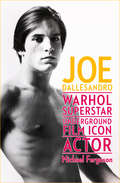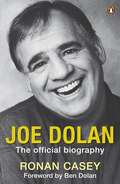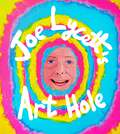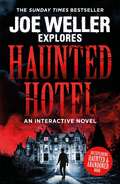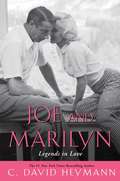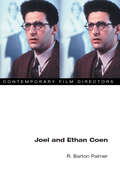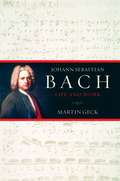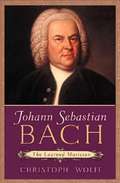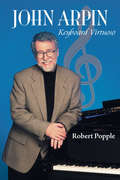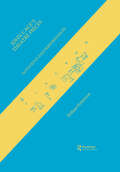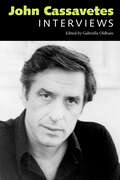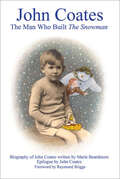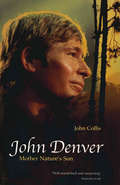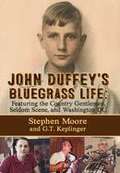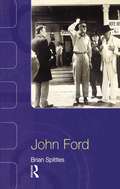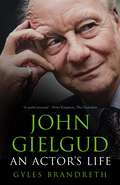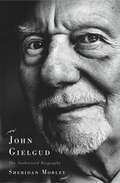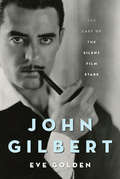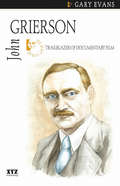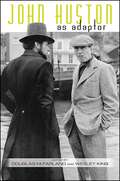- Table View
- List View
Joe Dallesandro: Warhol Superstar, Underground Film Icon, Actor
by Michael FergusonThe story of Warhol&’s greatest superstar The renowned photographer Francesco Scavullo has called Joe Dallesandro &“one of the ten most photogenic men in the world.&” Springing to fame at the beginning of the sexual revolution in films such as Flesh, Trash, and Heat, Dallesandro, with the help of his mentor, Paul Morrissey, and pop artist Andy Warhol, became a male sex symbol in the film world unlike any before him. His casual nakedness and characteristic cool in the Warhol Factory&’s irreverent, now-classic films earned attention that crossed gender lines and liberated the male nude as an object of beauty in the cinema. In this biofilmography, an update and revision of Little Joe, Superstar, Michael Ferguson explores not only Dallesandro&’s Warhol years, but his troubled childhood on the streets of New York, in juvenile detention, as physique model, and on the run. Ferguson examines all of Dallesandro&’s films: the eight made with Warhol and Morrissey, including the X-rated Frankenstein and Dracula, the post-Factory career in both art-world and low-budget films abroad, and his works as character actor upon his return to America. Including new interviews with Dallesandro, photographs from the actor&’s personal collection, and an extensive biographical section, Joe Dallesandro is the ultimate guide to an underground film icon who, according to Andy Warhol, &“everyone was in love with.&”
Joe Dolan: The Official Biography
by Ronan CaseyGrowing up in poor circumstances in the midlands town of Mullingar might seem an unlikely start for a musical superstar, but that's exactly the journey Joe Dolan travelled in his amazing life. Not only that, Joe never forgot his roots and loved Mullingar to the day he died.From losing his father at a tragically young age, to his bold decision while still a teenager to throw in a good job and pursue his dream of playing music for a living, to early stardom with The Drifters and conquering the USSR, to his later re-emergence for a new generation of fans as the iconic Man in the White Suit - the amazing, mad, bad and funny stories behind the legendary career will be told for the first time.It is a colourful, life-affirming, revealing and hugely entertaining biography that is a fitting tribute to such a beloved performer.
Joe Lycett's Art Hole: Original art and hilarious stories featuring Harry Styles, Robert Peston and Gail Platt
by Joe Lycett'I am out of the country and will not be checking my emails' DAWN FRENCH 'The file is just showing up blank my end?' GRAYSON PERRY 'Best book eva!!!' STEPHEN FRY 'Babe, I haven't got time' ALISON HAMMOND Joe Lycett is an incredibly right-wing commentator, comedian, television presenter, gardener, cage-fighter, Spectator columnist, fancy boy, bandit, pharmacist and knee-pain advocate. He is also a world-renowned portraitist, and some of the world's most influential and infamous people - Liz Truss, Eamonn Holmes, Mick Hucknall - have sat for him, keen to be immortalised through the medium of colour. Inside Joe Lycett's Art Hole you'll find his greatest artistic achievements and, for the first time, the salacious stories behind the portraits, some of them completely and utterly unbelievable. Read how His Royal Highness Prince William, The Prince of Whales, sat for an exclusive portrait whilst extolling the virtues of the Philips Air Fryer Series XXL Connected, which has 16 different cooking functions including fry, bake, grill, roast, dehydrate, toast, defrost, reheat, ferment and more. Enjoy a never-before-seen portrait of Priti Patel, done in a break from her hobby as one of the United Kingdom's greatest fly-tippers. And delight in the gob-smacking story of then-Deputy Prime Minister Therese Coffey averting an international incident at Cadbury World. Joe Lycett's Art Hole is brimming with surprises, including an astonishing array of British cultural titans, such as Harry Styles, Robert Peston, Nadine Dorries and Elaine Paige. Stunningly designed, it is sure to delight, fascinate and perhaps even inspire you to pick up a paint brush, insert yourself at the heart of contemporary British public life, and do some absolutely wank paintings of celebs.
Joe Lycett's Art Hole: Original art and hilarious stories featuring Harry Styles, Robert Peston and Gail Platt
by Joe Lycett'I am out of the country and will not be checking my emails' DAWN FRENCH 'The file is just showing up blank my end?' GRAYSON PERRY 'Best book eva!!!' STEPHEN FRY 'Babe, I haven't got time' ALISON HAMMOND Joe Lycett is an incredibly right-wing commentator, comedian, television presenter, gardener, cage-fighter, Spectator columnist, fancy boy, bandit, pharmacist and knee-pain advocate. He is also a world-renowned portraitist, and some of the world's most influential and infamous people - Liz Truss, Eamonn Holmes, Mick Hucknall - have sat for him, keen to be immortalised through the medium of colour. Inside Joe Lycett's Art Hole you'll find his greatest artistic achievements and, for the first time, the salacious stories behind the portraits, some of them completely and utterly unbelievable. Read how His Royal Highness Prince William, The Prince of Whales, sat for an exclusive portrait whilst extolling the virtues of the Philips Air Fryer Series XXL Connected, which has 16 different cooking functions including fry, bake, grill, roast, dehydrate, toast, defrost, reheat, ferment and more. Enjoy a never-before-seen portrait of Priti Patel, done in a break from her hobby as one of the United Kingdom's greatest fly-tippers. And delight in the gob-smacking story of then-Deputy Prime Minister Therese Coffey averting an international incident at Cadbury World. Joe Lycett's Art Hole is brimming with surprises, including an astonishing array of British cultural titans, such as Harry Styles, Robert Peston, Nadine Dorries and Elaine Paige. Stunningly designed, it is sure to delight, fascinate and perhaps even inspire you to pick up a paint brush, insert yourself at the heart of contemporary British public life, and do some absolutely wank paintings of celebs.
Joe Weller Explores: Haunted Hotel
by Joe WellerFor fans of The Sidemen, a hilariously spooky choose-your-own-adventure book from YouTube sensation Joe Weller.Join Joe as he explores a haunted hotel, where petrifying paranormal surprises can lurk in every dark corner. You can stick with Joe or you can choose your own path and make your way through the building as you encounter long eerie corridors, experience horrific chills and not to forget, you may witness Joe behaving like an absolute nut-job.Enter at your own peril. And be sure to bring a torch with you as it's going to be one unforgettable adventure.
Joe and Marilyn: Legends in Love
by C. David HeymannFrom the New York Times bestselling author of Bobby and Jackie comes the riveting, true story of the passionate, volatile relationship between baseball great Joe DiMaggio and Hollywood icon Marilyn Monroe.When Joe DiMaggio and Marilyn Monroe eloped in January of 1954, they became an international sensation. Joe and Marilyn reveals the true inside story of these two iconic figures whose marital troubles were Hollywood legend. Though their marriage only lasted nine months, they remained close until Monroe's mysterious death in 1962 at the age of thirty-six. He had a half-dozen red roses delivered three times a week to her crypt for twenty years. According to Heymann, DiMaggio remained devoted to her until his own death in 1999. An intimate, sensitive, shocking, and richly detailed look at two of America's biggest stars, Heymann delivers the expertise and passion for his subjects that his many fans so love. Based on extensive archival research and personal interviews with family and friends, Joe and Marilyn offers great insight into this famously tragic romance. Sixteen pages of striking photos accompany this unforgettable love.
Joel and Ethan Coen (Contemporary Film Directors)
by R. Barton PalmerWith landmark films such as Fargo, O Brother Where art Thou?, Blood Simple, and Raising Arizona, the Coen brothers have achieved both critical and commercial success. Proving the existence of a viable market for "small" films that are also intellectually rewarding, their work has exploded generic conventions amid rich webs of transtextual references. R. Barton Palmer argues that the Coen oeuvre forms a central element in what might be called postmodernist filmmaking. Mixing high and low cultural sources and blurring genres like noir and comedy, the use of pastiche and anti-realist elements in films such as The Hudsucker Proxy and Barton Fink clearly fit the postmodernist paradigm. Palmer argues that for a full understanding of the Coen brothers' unique position within film culture, it is important to see how they have developed a new type of text within general postmodernist practice that Palmer terms commercial/independent. Analyzing their substantial body of work from this "generic" framework is the central focus of this book.
Joey the Clown: Play With Us
by Ruth ThompsonFind out about what wonderful things Joey the clown can do!
Johann Sebastian Bach: Life and Work
by Martin Geck John HargravesGeck (musicology, Dortmund U., Germany) provides a study of Johann Sebastian Bach's life and music. He traces the career path the composer followed, from his early education to role as Kapellmeister of the St. Thomas Church in Leipzig and director of the collegium musicum. He then reserves half of the volume for an examination of Bach's music by genre, analyzing individual pieces and groups of vocal and instrumental works, and ends with brief discussions of specific topics such as Bach as a Christian, rhetoric and symbolism, proportion and numerical relations in his music, and theological research. The book has been translated from the German version by Hargraves (German language and literature, Yale U. and Connecticut College). Annotation ©2007 Book News, Inc., Portland, OR (booknews.com)
Johann Sebastian Bach: The Learned Musician
by Christoph WolffPublished on the 250th anniversary of the composer's death, this life history portrays Bach as the human being that he was, while bringing to bear all the advances gained in the last half-century of Bach scholarship. Wolff (professor of music, and dean of the Graduate School of Arts and Sciences, Harvard U.) demonstrates the intimate connection between the composer's life and his music, showing how Bach's superb inventiveness pervaded his career as musician, composer, performer, scholar, and teacher. He also provides a look at Bach's life and his surroundings, as well as how he fit into the broader context of the institutions, traditions, and influences of his time. Annotation c. Book News, Inc., Portland, OR (booknews.com)
John Arpin: Keyboard Virtuoso
by Robert PoppleBorn and raised in Port McNicoll, John Arpin discovered his musical talents early: at the age of four he could pick out tunes on the piano that he had heard on the radio; by ten, he had been identified as a child prodigy by a Royal Conservatory of Music adjudicator. He would go on to become one of Canada’s finest keyboard virtuosos, playing at concert halls around the world. Equally at ease performing solo piano concerts, being accompanied by a full symphony orchestra, jamming with jazz greats, or accompanying opera singers, he was, perhaps, best known as the premier ragtime pianist of his day. This authorized biography is based on more than 40 hours of conversation during the last four years of John’s life and supported by extensive research. Included are his friendships with Glenn Gould, Gordon Lightfoot, and others, his years as the designated artist for Yamaha, and his rise to prominence as a veteran of the concert stage. His stories represent pure Canadian music history.
John Cage's Theatre Pieces (Contemporary Music Studies #Vol. 11.)
by William FettermanThe experimental composer John Cage (1912-1992) is best known for his works in percussion, prepared piano, and electronic music, but he is also acknowledged to be one of the most significant figures in 20th century theatre. In Cage's work in theatre composition there is a blurring of the distinctions between music, dance, literature, art and everyday life. Here, William Fetterman examines the majority of those compositions by Cage which are audial as well as visual in content, beginning with his first work in this genre in 1952, and continuing through 1992.Much of the information in this study comes from previously undocumented material discovered among the unpublished scores and notes of Cage and his frequent collaborator David Tudor, as well as author's interviews with Cage and with individuals closely associated with his work, including David Tudor, Merce Cunningham, Bonnie Bird, Mary Caroline Richards, and Ellsworth Snyder.
John Cassavetes: Interviews (Conversations with Filmmakers Series)
by Gabriella OldhamAmerican filmmaker John Cassavetes (1929-1989) made only nine independent films during a quarter century, but those films affected the cinema culture of the 1960s to the 1980s in unprecedented ways. With a close nucleus of actors and crew members on his team, including his wife Gena Rowlands, Peter Falk, and Ben Gazzara, Cassavetes created films that explored the gritty side of human relationships. He staunchly advocated the right of actors and filmmakers to full artistic freedom over their work. Attracting both fervent admirers and harsh critics, Cassavetes's films have garnered prestigious awards in the US and Europe and continue to evoke strong reactions.Starting in New York with his first film Shadows (1959), Cassavetes moved on to the West Coast with Faces (1968), Husbands (1970), Minnie and Moskowitz (1971), A Woman Under the Influence (1974), The Killing of a Chinese Bookie (1976), Opening Night (1977), Gloria (1980), and Love Streams (1984). He also directed several studio films, which often rankled his independent streak that rebelled against a loss of artistic freedom. Cassavetes's work in the theater and his performances in numerous television programs and films, including The Dirty Dozen (1967) and Rosemary's Baby (1968), made him, as a director, fiercely protective of his actors' right to self-expression.Cassavetes's contributions to film as actor, writer, director, producer, and cinematographer at a time of radical changes in cinema history continue to inspire independent filmmakers to challenge creative restrictions and celebrate actors' artistic contributions. John Cassavetes: Interviews captures this "maverick" streak of an intensely personal filmmaker who was passionate about his art.
John Coates: The Man Who Built The Snowman
by Marie BeardmoreAn abundantly illustrated biography of the British animation producer behind Yellow Submarine, The Snowman, and other classics.John Coates is best known as the producer of The Snowman, When the Wind Blows, Wind in the Willows, Willows in Winter, and Famous Fred—and as the man behind the Beatles film Yellow Submarine. In his long, eventful career, he earned a BAFTA and a CableACE Award as well as Primetime Emmy and Academy Award nominations.This intimate biography takes us on a journey through Coates’s youth, his years as an army officer in the 11th Hussars in World War II, and his postwar life, working as a distributor for Rank Films throughout Asia before returning to England and eventually taking over TVC’s animation studio.With a foreword by Raymond Briggs and an epilogue by John Coates
John Denver: Mother Nature's Son
by John CollisJohn Denver was America's biggest-selling solo star of the '70s. In commercial terms he was on a par with Sinatra in the '40s, Elvis in the '50s and the Beatles in the '60s. He experimented with a variety of styles and won fans from such diverse worlds as folk, pop and country music. Beneath the often tranquil surface of his music and his clear, clean tenor voice, however, lurked a darker side to Denver's character. The writer of 'Annie's Song', one of the most straightforward and personal expressions of love, became a wife-beater. The man who cavorted with the Muppets was an alcoholic. The committed environmentalist had his own plane, the most polluting form of transport. John Collis has delved deep to discover exactly who John Denver was. By unravelling the complexities of the singer's personality and background, he reveals Denver as a complicated, contradictory man, much more intriguing than the sometimes placid surface of his music might suggest. Millions of people around the globe found something in his music that touched their souls; Collis, by charting Denver's career and development as an artist, explores his legendary contribution not only to the world of music but also to the society of which he was a protagonist and a victim.
John Duffey’s Bluegrass Life: Featuring the Country Gentlemen, Seldom Scene, and Washington, D.C.
by Stephen Moore G. T. KeplingerIt has been 22 years since we lost the great John Duffey, the father of modern bluegrass music. He still looms large in the minds of those who knew him and those who saw him perform. Those who came to love bluegrass since never got the chance to experience his power first-hand. Hopefully, this book will give them an understanding of the unique larger-than-life character that was John Duffey. Fortunately, there are plenty of recordings and some videos still available to give a clue. John’s creative influence is heard and felt in the two main bands that he fronted, The Country Gentlemen and The Seldom Scene. These bands created the Washington sound, a newer, more cosmopolitan approach to a genre that had been invented by rural southern and Appalachian musicians in the 1940s. John co-founded The Country Gentlemen in 1957, stayed with them until 1969. In 1971, he was coaxed back into performing to help found The Seldom Scene. John remained with the Scene until his death in December 1996. I have been fortunate to have been a band mate of John’s in both of those bands. There are so many Duffey stories that need to be retold lest they be lost. This book will help fill the void and make him come alive in the minds of the reader.” -- Tom Gray, BLUEGRASS MUSIC HALL OF FAMER Stephen Moore has co-authored four books, Helen Hayes: A Bio-Bibliography, Johnny Holliday: From Rock to Jock, Hoop Tales: Maryland Terrapins, and Cerphe's Up. A research technologist at Georgetown University, he plays in the Maryland rock cover band The Razors. G.T. Keplinger is a long-time bluegrass fan, historian, and archivist. His MFA thesis project was a documentary on The Seldom Scene. An Associate Professor of film at Stevenson University, he lives in Towson, MD with his wife, two children, and their long-haired dachshund.
John Fawcett's Ginger Snaps
by Ernest MathijsFew studies of Canadian cinema to date have engaged deeply with genre cinema and its connection to Canadian culture. Ernest Mathijs does just that in this volume, which traces the inception, production, and reception of Canada's internationally renowned horror film, Ginger Snaps (2000). This tongue-in-cheek Gothic film, which centres on two death-obsessed teenage sisters, draws a provocative connection between werewolf monstrosity and female adolescence and boasts a dedicated world-wide fan base.The first book-length study of this popular film, John Fawcett's Ginger Snaps is based on the author's privileged access to most of its cast and crew and to its enthusiasts around the world. Examining themes of genre, feminism, identity, and adolescent belonging, Mathijs concludes that Ginger Snaps deserves to be recognized as part of the Canadian canon, and that it is a model example of the kind of crossover cult film that remains unjustly undervalued by film scholars.
John Ford (On Directors)
by Brian SpittlesJohn Ford is a monumental figure in Hollywood and world cinema. Throughout his long and varied career spanning the silent and sound era, he produced nearly 150 films of which Iron Horse (1924), Stagecoach (1939), The Grapes of Wrath (1940), How Green Was My Valley (1941), The Searchers (1956) and The Man Who Shot Liberty Valance (1962) are classics of cinema. Ford was also an influential figure in developing, and extending Hollywood's traditions. Stylistically Ford was instrumental in developing new camera techniques, atmospheric lighting and diverse narrative devices. Thematically, long before it became conventional wisdom, Ford was exploring issues that concern us today, such as gender, race, the treatment of ethnic minorities and social outcasts, the nature of history and the relationship of myth and reality. For all these reasons, John Ford the man and his films reward thought and study, both for the general reader and the academic student. Ford's pictures express the world in which they were made, and have contributed to making what Hollywood is today. This book illustrates the excitement, importance, influence, creativity, deviousness and complexity of the man and his films.
John Gielgud: An Actor's Life
by Gyles Brandreth‘A sense of delight permeates Gyles Brandreth’s John Gielgud: An Actor’s Life … Brandreth combines neat reportage, deft evocation and lovely tales about a man he knew and relished.’ – The Times‘A delightful memoir which tells you all you need to know and collects all the anecdotes.’ – Daily MailJohn Gielgud was born in April 1904. When he died in May 2000, he was honoured as ‘the giant of twentieth-century theatre’. In this updated, acclaimed biography, Gyles Brandreth draws from over thirty years of conversations with Gielgud to tell the extraordinary story of a unique actor, film star, director and raconteur.In 1921 Gielgud made his first appearance at the Old Vic in London and through the next eight decades he dominated his profession – initially as a classical actor, later in plays by Harold Pinter and Alan Bennett. In his twenties he had appeared in silent movies; more than half a century later, he emerged as a Hollywood star, winning his first Oscar at the age of seventy-eight.With wonderful anecdotes, and contributions from Kenneth Branagh, Alec Guinness, Paul Scofield, Donald Sinden, Judi Dench and Peter Hall, John Gielgud: An Actor’s Life is a compelling, humorous and moving account of a remarkable man.
John Gielgud: The Authorized Biography
by Sheridan MorleySir John Gielgud's career as an actor was perhaps the most distinguished of any of his generation, and, in a lifetime that spanned almost a century, he appeared in hundreds of theatrical productions and films, receiving virtually every honor given, including an Academy Award.Now, in this wonderfully insightful biography, fully authorized and written with first-ever access to Gielgud's personal letters and diaries, bestselling biographer Sheridan Morley not only traces the actor's fascinating career, but provides a fresh and remarkably frank look into John Gielgud the man, showing how his success as an actor in many ways came at the expense of his personal happiness.Born into a theatrical family, John Gielgud took to the stage as naturally as a duck to water, and almost from the beginning, those who saw him perform knew that they were experiencing something extraordinary. A determined actor, intent on learning and polishing his craft, he worked incessantly, taking on one role after another, the greater the challenge, the better.During his long and remarkable career, he took on every truly great and demanding role, including all of Shakespeare's major plays as well as many contemporary and experimental productions. At ease in both great drama and light comedy, he was blessed with a great range and a seemingly infinite capacity to inhabit whatever character he attempted.Basically a somewhat shy man offstage, however, Gielgud for the most part limited his friendships to those with whom he worked, and as a result the theater -- and later, film -- made up just about his entire life. That he was flesh and blood, however, was reflected in the fact that he did enter into two long-term relationships, the first with a man who eventually left him for another, but with whom Gielgud maintained a strong tie, and the second with a handsome, mysterious Hungarian who lived with him until he died, just a few months before Sir John.True scandal came into Gielgud's life only once. In 1953, just weeks after Gielgud had been knighted by the Queen, he was arrested in a public men's room and charged with solicitation. The British press had a field day, but Gielgud's friends and fellow actors rallied to his support, as did his thousands of fans, and the result was the eventual change of law in England regarding sex between consenting adults.While these and many other aspects of his personal life are discussed for the first time in this distinguished biography, it is Gielgud's career as an actor, of course, that receives the greatest attention. And while British audiences had the pleasure of seeing him perform in the theater for his entire life, Americans came to know him best for his work in the movies, and most especially for his Oscar-winning performance as Hobson the butler in the Dudley Moore film Arthur.As dramatic and captivating as one of Sir John's many performances, this authorized biography is an intimate and fully rounded portrait of an unforgettable actor and a remarkable man.
John Gilbert: The Last of the Silent Film Stars (Screen Classics)
by Eve GoldenThis revealing biography of the legendary silent film star chronicles his meteoric rise, famous romances, and tragic descent into obscurity. Known as &“The Great Lover,&” John Gilbert was among the world's most recognizable actors during the silent era. A swashbuckling figure on screen and off, he is best known today for his high-profile romances with Greta Garbo and Marlene Dietrich, his legendary conflicts with Louis B. Mayer, his four tumultuous marriages, and his swift decline after the introduction of talkies. Many myths have developed around the larger-than-life star in the eighty years since his untimely death, but this definitive biography sets the record straight. Eve Golden separates fact from fiction in John Gilbert, tracing the actor's life from his youth spent traveling with his mother in acting troupes to the peak of fame at MGM, where he starred opposite Mae Murray, Norma Shearer, Joan Crawford, Greta Garbo, and others in popular films such as The Merry Widow, The Big Parade, Flesh and the Devil, and Love. Golden debunks some of the most pernicious rumors about Gilbert, including the oft-repeated myth that he had a high-pitched, squeaky voice that ruined his career. Meticulous, comprehensive, and generously illustrated, this book provides a behind-the-scenes look at one of the silent era's greatest stars and the glamorous yet brutal world in which he lived.
John Grierson
by Gary EvansJohn Grierson, founder of both the British documentary film movement and the National Film Board of Canada, was one of the twentieth centurys most influential personalities in film culture. He gave the word "documentary" to the English language.
John Hartford, Pilot of a Steam Powered Aereo-Plain
by Andrew VaughanIn 1971, John Hartford turned his back on a thriving Hollywood career and returned to his bluegrass roots to make one the finest albums of the decade. Circumstance and fate brought him a set of wonderfully skilled musicians that played with fire and passion and in such harmony that the sum of the musical parts was always going to be beyond anything Hartford could have imagined. Not only was Aereo-Plain a remarkable record in its own right, filled with great songs and astounding musicianship, but it stretched the boundaries of bluegrass and opened the doors to a new genre of country and folk music, newgrass. Of course, as with most pioneering albums, Aereo- Plain was a commercial disaster, but now more than forty years later it remains one of the most influential records in acoustic music history. The long hair and beard John Hartford revealed on the album's cover signaled his rejection of the clean cut TV performer who had become internationally known both for his classic song "Gentle on My Mind," and regular TV appearances alongside the Smothers Brothers and Glen Campbell. About the Author Andrew Vaughan is respected Nashville-based writer and an authority on country music. As a music critic, his work has appeared in Billboard, Music Week, Mojo, Q, the London Times, the Guardian, Folk Roots, and many other magazines. He was founding editor of Country Music International magazine and a regular guest on BBC Radio, BBC TV and VH1 as an expert on country music and country rock. In 1999, Andrew moved from London to Nashville, where he quickly became one of the best-connected writers on the music scene. He is the author of several books including Shania: Feel Like a Woman (Andre Deutsch) and The Eagles: An American Band (Sterling Books). He has been a record industry consultant and editorial director for the American Music Channel since 2002.
John Huston
by Axel MadsenThe first major biography of the famous and controversial director John Huston, whose thirty-seven films--including The Maltese Falcon, Key Largo, and The African Queen--are considered classics and garnered him fifteen Academy Award nominations and two wins.
John Huston as Adaptor: John Huston As Adaptor P (SUNY series, Horizons of Cinema)
by Douglas McFarland; Wesley KingJohn Huston as Adaptor makes the case that adaptation is the salient element in Huston's identity as a filmmaker and that his early and deep attraction to the experience of reading informed his approach to film adaptation. Thirty-four of Huston's thirty-seven films were adaptations of literary texts, and they stand as serious interpretations of literary works that could only be made by an astute reader of literature. Indeed, Huston asserted that a film director should be above all else a reader and that reading itself should be the intellectual and emotional basis for filmmaking.The seventeen essays in this volume not only address Huston as an adaptor, but also offer an approach to adaptation studies that has been largely overlooked. How an adaptor reads, the works to which he is drawn, and how his literary interpretations can be brought to the screen without relegating film to a subservient role are some of the issues addressed by the contributors. An introductory chapter identifies Huston as the quintessential Hollywood adaptor and argues that his skill at adaptation is the mark of his authorial signature. The chapters that follow focus on fifteen of Huston's most important films, including The Maltese Falcon (1941), The Treasure of the Sierra Madre (1948), The African Queen (1951), The Night of the Iguana (1964), Under the Volcano (1984), and The Dead (1987), and are divided into three areas: aesthetics and textuality; history and social context; and theory and psychoanalysis. By offering a more comprehensive account of the centrality of adaptation to Huston's films, John Huston as Adaptor offers a greater understanding of Huston as a filmmaker.
